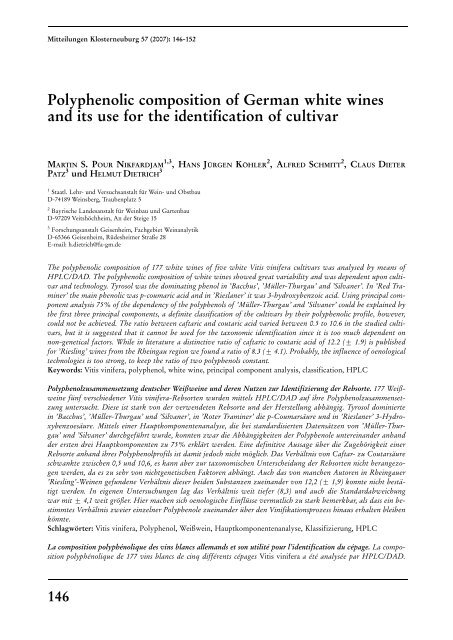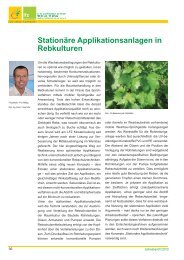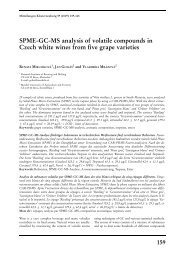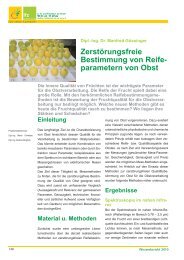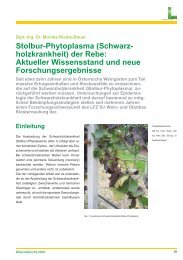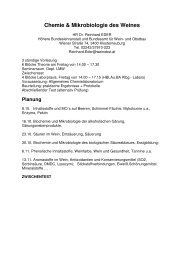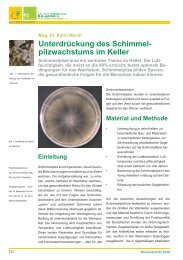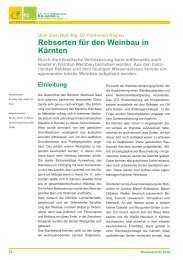Polyphenolic composition of German white wines and its use for the ...
Polyphenolic composition of German white wines and its use for the ...
Polyphenolic composition of German white wines and its use for the ...
You also want an ePaper? Increase the reach of your titles
YUMPU automatically turns print PDFs into web optimized ePapers that Google loves.
Mitteilungen Klosterneuburg 57 (2007): 146-152<br />
<strong>Polyphenolic</strong> <strong>composition</strong> <strong>of</strong> <strong>German</strong> <strong>white</strong> <strong>wines</strong><br />
<strong>and</strong> <strong>its</strong> <strong>use</strong> <strong>for</strong> <strong>the</strong> identification <strong>of</strong> cultivar<br />
MARTIN S. POUR NIKFARDJAM 1,3 ,HANS JUÈ RGEN KOÈ HLER 2 ,ALFRED SCHMITT 2 ,CLAUS DIETER<br />
PATZ 3 und HELMUT DIETRICH 3<br />
1 Staatl. Lehr- und Versuchsanstalt fuÈ r Wein- und Obstbau<br />
D-74189 Weinsberg, Traubenplatz 5<br />
2 Bayrische L<strong>and</strong>esanstalt fuÈ r Weinbau und Gartenbau<br />
D-97209 Ve<strong>its</strong>hoÈ chheim, An der Steige 15<br />
3 Forschungsanstalt Geisenheim, Fachgebiet Weinanalytik<br />
D-65366 Geisenheim, RuÈ desheimer Straûe 28<br />
E-mail: h.dietrich@fa-gm.de<br />
The polyphenolic <strong>composition</strong> <strong>of</strong> 177 <strong>white</strong> <strong>wines</strong> <strong>of</strong> five <strong>white</strong> Vitis vinifera cultivars was analysed by means <strong>of</strong><br />
HPLC/DAD.The polyphenolic <strong>composition</strong> <strong>of</strong> <strong>white</strong> <strong>wines</strong> showed great variability <strong>and</strong> was dependent upon cultivar<br />
<strong>and</strong> technology.Tyrosol was <strong>the</strong> dominating phenol in 'Bacchus', 'MuÈ ller-Thurgau' <strong>and</strong> 'Silvaner'.In 'Red Traminer'<br />
<strong>the</strong> main phenolic was p-coumaric acid <strong>and</strong> in 'Rieslaner' it was 3-hydroxybenzoic acid.Using principal component<br />
analysis 75% <strong>of</strong> <strong>the</strong> dependency <strong>of</strong> <strong>the</strong> polyphenols <strong>of</strong> 'MuÈ ller-Thurgau' <strong>and</strong> 'Silvaner' could be explained by<br />
<strong>the</strong> first three principal components, a definite classification <strong>of</strong> <strong>the</strong> cultivars by <strong>the</strong>ir polyphenolic pr<strong>of</strong>ile, however,<br />
could not be achieved. The ratio between caftaric <strong>and</strong> coutaric acid varied between 0.5 to 10.6 in <strong>the</strong> studied cultivars,<br />
but it is suggested that it cannot be <strong>use</strong>d <strong>for</strong> <strong>the</strong> taxonomic identification since it is too much dependent on<br />
non-genetical factors.While in literature a distinctive ratio <strong>of</strong> caftaric to coutaric acid <strong>of</strong> 12.2 (+ 1.9) is published<br />
<strong>for</strong> 'Riesling' <strong>wines</strong> from <strong>the</strong> Rheingau region we found a ratio <strong>of</strong> 8.3 (+ 4.1). Probably, <strong>the</strong> influence <strong>of</strong> oenological<br />
technologies is too strong, to keep <strong>the</strong> ratio <strong>of</strong> two polyphenols constant.<br />
Keywords: Vitis vinifera, polyphenol, <strong>white</strong> wine, principal component analysis, classification, HPLC<br />
Polyphenolzusammensetzung deutscher Weiûweine und deren Nutzen zur Identifizierung der Rebsorte. 177 Weiûweine<br />
fuÈ nf verschiedener Vitis vinifera-Rebsorten wurden mittels HPLC/DAD auf ihre Polyphenolzusammensetzung<br />
untersucht.Diese ist stark von der verwendeten Rebsorte und der Herstellung abhaÈngig.Tyrosol dominierte<br />
in 'Bacchus', 'MuÈ ller-Thurgau' und 'Silvaner', in 'Roter Traminer' die p-CoumarsaÈure und in 'Rieslaner' 3-HydroxybenzoesaÈure.Mittels<br />
einer Hauptkomponentenanalyse, die bei st<strong>and</strong>ardisierten DatensaÈtzen von 'MuÈ ller-Thurgau'<br />
und 'Silvaner' durchgefuÈ hrt wurde, konnten zwar die AbhaÈngigkeiten der Polyphenole unterein<strong>and</strong>er anh<strong>and</strong><br />
der ersten drei Hauptkomponenten zu 75% erklaÈrt werden.Eine definitive Aussage uÈ ber die ZugehoÈ rigkeit einer<br />
Rebsorte anh<strong>and</strong> ihres Polyphenolpr<strong>of</strong>ils ist damit jedoch nicht moÈ glich.Das VerhaÈltnis von Caftar- zu CoutarsaÈure<br />
schwankte zwischen 0,5 und 10,6, es kann aber zur taxonomischen Unterscheidung der Rebsorten nicht herangezogen<br />
werden, da es zu sehr von nichtgenetischen Faktoren abhaÈngt.Auch das von manchen Autoren in Rheingauer<br />
'Riesling'-Weinen gefundene VerhaÈltnis dieser beiden Substanzen zuein<strong>and</strong>er von 12,2 (+ 1,9) konnte nicht bestaÈtigt<br />
werden.In eigenen Untersuchungen lag das VerhaÈltnis weit tiefer (8,3) und auch die St<strong>and</strong>ardabweichung<br />
war mit + 4,1 weit groÈ ûer.Hier machen sich oenologische EinfluÈ sse vermutlich zu stark bemerkbar, als dass ein bestimmtes<br />
VerhaÈltnis zweier einzelner Polyphenole zuein<strong>and</strong>er uÈ ber den Vinifikationsprozess hinaus erhalten bleiben<br />
koÈ nnte.<br />
SchlagwoÈ rter: Vitis vinifera, Polyphenol, Weiûwein, Hauptkomponentenanalyse, Klassifizierung, HPLC<br />
La <strong>composition</strong> polypheÂnolique des vins blancs allem<strong>and</strong>s et son utilite pour l'identification du ceÂpage. La <strong>composition</strong><br />
polypheÂnolique de 177 vins blancs de cinq diffeÂrents ceÂpages Vitis vinifera aeÂte analyseÂe par HPLC/DAD.<br />
146
Mitteilungen Klosterneuburg 57 (2007): 146-152 Pour Nikfardjam et al.<br />
Cette <strong>composition</strong> est <strong>for</strong>tement deÂpendante du ceÂpage utilise et du mode de production.Le tyrosol dominait dans<br />
'Bacchus', 'MuÈ ller-Thurgau' et 'Silvaner', pour le 'Roter Traminer' c'eÂtait l'acide p-coumarique et pour le 'Rieslaner'<br />
l'acide 3-hydroxy-benzoyÂque.Il est vrai que les interdeÂpendances des polypheÂnols ont pu eÃtre expliqueÂes aÁ 75%au<br />
moyen de l'analyse en composantes principales, en utilisant les trois premieÁres composantes principales, mais cela ne<br />
permet pas de faire une deÂclaration deÂfinitive relative aÁ l'appartenance d'un ceÂpage sur la base de son pr<strong>of</strong>il polypheÂnolique.Le<br />
rapport entre l'acide caftarique et l'acide coutarique variait entre 0,5 et 10,6.Il ne peut cependant pas<br />
eÃtre utilise pour une distinction taxonomique des ceÂpages, eÂtant donne que la deÂpendance des facteurs non-geÂneÂtiques<br />
est trop gr<strong>and</strong>e.Il n'a eÂgalement pas eÂte possible de confirmer le rapport entre ces deux substances de 12,2 (+<br />
1,9), trouve par quelques auteurs dans les vins 'Riesling' de la reÂgion allem<strong>and</strong>e «Rheingau».Dans nos propres analyses,<br />
nous avons trouve un rapport beaucoup plus bas (8,3) et la deÂviation st<strong>and</strong>ard de + 4,1 eÂtait largement plus<br />
importante.Ici, les influences únologiques sont probablement trop <strong>for</strong>tes pour que le rapport de deux polypheÂnols<br />
diffeÂrents puisse se conserver au-delaÁ du processus de vinification.<br />
Mots cleÂs : Vitis vinifera, polypheÂnols, vin blanc, analyse en composantes principales, classification, HPLC<br />
A reliable method <strong>for</strong> <strong>the</strong> determination <strong>of</strong> <strong>the</strong> varietal<br />
origin <strong>of</strong> <strong>wines</strong> is <strong>of</strong> great interest to both wine industry<br />
<strong>and</strong> consumer. The individual polyphenolic fingerprint<br />
as reflected in <strong>the</strong> <strong>composition</strong> <strong>of</strong> hydroxycinnamic<br />
<strong>and</strong> hydroxybenzoic acids, as well as flavonoids <strong>and</strong><br />
<strong>the</strong>ir derivatives, is distinctive <strong>for</strong> any plant. For red<br />
cultivars <strong>the</strong> analysis <strong>of</strong> <strong>the</strong> anthocyanin <strong>composition</strong><br />
<strong>and</strong> <strong>the</strong> content <strong>of</strong> shikimic acid have been mainly<br />
<strong>use</strong>d <strong>for</strong> distinguishing among red grape cultivars.<br />
Commonly, HPLC methods are <strong>use</strong>d to analyse this<br />
part <strong>of</strong> <strong>the</strong> phenolic fingerprint. They have been successfully<br />
<strong>use</strong>d in <strong>German</strong>y <strong>for</strong> <strong>the</strong> au<strong>the</strong>nticity control<br />
<strong>of</strong> 'Pinot noir' <strong>wines</strong> (EDER at al., 1994; HOLBACH et<br />
al., 1997; HOLBACH et al., 1998; EDER <strong>and</strong> HOLBACH,<br />
1998). Although <strong>the</strong> polyphenolic <strong>composition</strong> <strong>of</strong> wine<br />
may be influenced by different factors such as varietal<br />
(VRHOVSEK et al., 1997) <strong>and</strong> viticultural influence<br />
(OTREBA et al., 2006), vinification, maturation <strong>and</strong><br />
aging, <strong>the</strong> differences in <strong>the</strong> overall phenolic fingerprints<br />
might still be characteristic <strong>for</strong> each cultivar.<br />
Even in very old <strong>white</strong> <strong>wines</strong>, polyphenols can be detected<br />
as was shown <strong>for</strong> 'Riesling' <strong>wines</strong> from vintages<br />
1892 to 1921 (DIETRICH et al., 2004). In fact, in earlier<br />
studies HPLC methods have already been <strong>use</strong>d <strong>for</strong> <strong>the</strong><br />
identification <strong>of</strong> <strong>white</strong> grape cultivars. RITTER et al.<br />
(1994) showed that 'Riesling' <strong>wines</strong> from <strong>the</strong> <strong>German</strong><br />
Rheingau region have a distinctive ratio <strong>of</strong> 12.2 (+<br />
1.9) <strong>for</strong> <strong>the</strong> two polyphenols caftaric <strong>and</strong> coutaric acid.<br />
PRESA-OWENS et al. (1995) found a similar ratio <strong>for</strong> <strong>the</strong>se<br />
two compounds in Spanish <strong>white</strong> <strong>wines</strong> from <strong>the</strong> Penedes<br />
region. They also showed that principal component<br />
analysis (PCA) <strong>of</strong> <strong>the</strong> polyphenolic fraction achieved a<br />
separation according to cultivar. In more recent studies<br />
polyphenolic fingerprints have been <strong>use</strong>d to identify<br />
<strong>the</strong> vintage, geographic <strong>and</strong> even winery origin <strong>of</strong> red<br />
<strong>and</strong> <strong>white</strong> <strong>wines</strong> (POUR NIKFARDJAM et al., 2006; PENÄ A-<br />
NEIRA et al., 2000; TINTTUNEN <strong>and</strong> LEHTONEN, 2001; DE<br />
VILLIERS et al., 2005). The current knowledge on <strong>the</strong><br />
presence <strong>of</strong> phenolic compounds in wine can be found<br />
in <strong>the</strong> review <strong>of</strong> MONAGAS et al. (2005).<br />
From our point <strong>of</strong> view it was interesting to see if various<br />
winemaking practices have a significant effect on<br />
<strong>the</strong> polyphenolic <strong>composition</strong> <strong>of</strong> <strong>German</strong> <strong>white</strong> wine.<br />
Importantly, we wanted to observe if <strong>the</strong> ratio <strong>of</strong> certain<br />
compounds remains constant regardless to winemaking<br />
practice <strong>and</strong>, <strong>the</strong>re<strong>for</strong>e, can be <strong>use</strong>d <strong>for</strong> <strong>the</strong><br />
identification <strong>of</strong> <strong>the</strong> cultivar. TREUTTER (1989), BOURSI-<br />
QUOT (1987) <strong>and</strong> RITTER et al. (1994) stated that especially<br />
<strong>the</strong> ratio <strong>of</strong> caftaric <strong>and</strong> coutaric acid in grapes is<br />
genetically controlled, which we also wanted to verify<br />
within <strong>the</strong> scope <strong>of</strong> this study. Fur<strong>the</strong>rmore, as RITTER<br />
et al. (1994) described, <strong>the</strong> ratio being dependent on<br />
'Riesling' from <strong>the</strong> Rheingau region only, we also collected<br />
samples from this region <strong>and</strong> analysed <strong>the</strong>ir polyphenolic<br />
<strong>composition</strong>.<br />
Materials <strong>and</strong> Methods<br />
Wine samples<br />
177 <strong>white</strong> <strong>wines</strong> <strong>of</strong> five different Vitis vinifera cultivars<br />
('Bacchus', 'MuÈ ller-Thurgau', 'Rieslaner', 'Silvaner',<br />
<strong>and</strong> 'Traminer') <strong>and</strong> different vinification techniques<br />
from vintages between 1989 <strong>and</strong> 1998 were collected<br />
from <strong>the</strong> Bayrische L<strong>and</strong>esanstalt fuÈ r Weinbau und<br />
Gartenbau in Ve<strong>its</strong>hoÈ chheim (<strong>German</strong>y). Seventeen<br />
'Riesling' <strong>wines</strong> from <strong>the</strong> <strong>German</strong> Rheingau region<br />
were purchased from local wineries.<br />
HPLC analysis<br />
Analysis was per<strong>for</strong>med using <strong>the</strong> method published by<br />
RECHNER et al. (1998). All samples were directly injec-<br />
147
Mitteilungen Klosterneuburg 57 (2007): 146-152 Pour Nikfardjam et al.<br />
ted into a HPLC (L-6200A, Merck-Hitachi) equipped<br />
with an autosampler (AS-2000, Merck-Hitachi), <strong>and</strong> a<br />
diode-array detector (DAD, LaChrom L-7210, Merck).<br />
Chromatograms were recorded at 280 <strong>and</strong> 320 nm. The<br />
column temperature was maintained at 25 8C with a<br />
Column Oven (Biorad). The injection volume was<br />
10 ml. Identification <strong>and</strong> quantification <strong>of</strong> <strong>the</strong> compounds<br />
was carried out using DAD spectra. Hydroxycinnamic<br />
esters were quantified as <strong>the</strong>ir corresponding<br />
free acids.<br />
Data analysis<br />
All data analysis was carried out using Unscrambler<br />
S<strong>of</strong>tware (Camo, Norway, Version 7.6).<br />
Total polyphenol content (Folin-Ciocalteu)<br />
The total polyphenol content was determined using <strong>the</strong><br />
method <strong>of</strong> Ritter (1994) with (+)-catechin as st<strong>and</strong>ard.<br />
Results <strong>and</strong> discussion<br />
General polyphenolic <strong>composition</strong><br />
Table 1 shows <strong>the</strong> mean polyphenolic <strong>composition</strong> <strong>of</strong><br />
<strong>the</strong> 177 <strong>wines</strong> from Ve<strong>its</strong>hoÈ chheim analysed with<br />
HPLC.<br />
The most abundant polyphenols in 'Bacchus' were tyrosol<br />
<strong>and</strong> coumaric acid followed by p-coumaroylglucosyltartrate<br />
(p-CGT) <strong>and</strong> protocatechuic acid. No flavan-<br />
3-ols could be detected in this cultivar. Generally speaking,<br />
'Bacchus' had relatively low total concentrations<br />
<strong>of</strong> polyphenols (Folin: mean value 192mg/l). Also <strong>the</strong><br />
concentration <strong>of</strong> cinnamic acid derivatives was quite low.<br />
Tyrosol was also <strong>the</strong> most abundant phenolic compound<br />
in 'MuÈ ller-Thurgau'. Some <strong>wines</strong> also contained<br />
considerable amounts <strong>of</strong> catechin (7.0 mg/l), procyanidin<br />
B2 (39.5 mg/l), epicatechin (12.3 mg/l), <strong>and</strong> p-coumaric<br />
acid (15.4 mg/l). This cultivar showed <strong>the</strong> highest<br />
amounts <strong>of</strong> tyrosol, procyanidin B2, <strong>and</strong> epicatechin<br />
within <strong>the</strong> scope <strong>of</strong> this study. The low amounts <strong>of</strong> caftaric<br />
acid are probably due to enzymatic or oxidative<br />
losses during vinification.<br />
We also analysed three 'MuÈ ller-Thurgau' <strong>wines</strong>, which<br />
had been fermented on <strong>the</strong> skins (not included in Table<br />
1). These <strong>wines</strong> had especially high amounts <strong>of</strong> caftaric<br />
acid, catechin, GRP, procyanidin B2, epicatechin, <strong>and</strong><br />
rutin (quercetin-3-rutinosid) (Table 2). They also showed<br />
very high Folin values. The flavan-3-ols contributed<br />
<strong>the</strong> main part to <strong>the</strong> total polyphenol content. Interestingly,<br />
caftaric acid was <strong>the</strong>n <strong>the</strong> most abundant poly-<br />
148<br />
phenol, but not tyrosol. This could be due to <strong>the</strong> fact<br />
that a high amount <strong>of</strong> flavan-3-ols leads to a strong antioxidative<br />
protection <strong>of</strong> oxidative sensitive phenols,<br />
such as hydroxycinnamic acids, <strong>and</strong> at <strong>the</strong> same time inhib<strong>its</strong><br />
<strong>the</strong> oxidative <strong>for</strong>mation <strong>of</strong> tyrosol out <strong>of</strong> <strong>the</strong><br />
amino acid tyrosine.<br />
'Rieslaner' showed to be <strong>the</strong> cultivar with <strong>the</strong> highest<br />
amount <strong>of</strong> polyphenols determined by HPLC. It was<br />
nearly twice as high compared to all <strong>the</strong> o<strong>the</strong>r cultivars<br />
analysed. This is mainly due to <strong>its</strong> high amounts <strong>of</strong><br />
3-hydroxybenzoic acid (Table 1). This cultivar also showed<br />
relatively high amounts <strong>of</strong> flavan-3-ols (16.3 mg/l<br />
<strong>for</strong> procyanidin B2) <strong>and</strong> a relatively high mean content<br />
<strong>of</strong> caftaric acid (19.9mg/l). The high polyphenolic content<br />
could have provided a strong antioxidative capacity,<br />
which prevented caftaric acid from becoming oxidized.<br />
Beca<strong>use</strong> <strong>of</strong> <strong>the</strong> small number <strong>of</strong> samples (n = 7)<br />
it could not be determined if this is a characteristic <strong>for</strong><br />
this cultivar.<br />
Tyrosol was <strong>the</strong> dominant polyphenol in <strong>the</strong> 17 analysed<br />
'Riesling' <strong>wines</strong>. The second most important polyphenol<br />
was caftaric acid. The <strong>wines</strong> showed generally<br />
low concentrations on flavan-3-ols, such as catechin,<br />
epicatechin, <strong>and</strong> procyanidin B 2, which could be an indicator<br />
<strong>for</strong> a gentle winemaking procedure. Also <strong>the</strong> levels<br />
on GRP were relatively low (mean: 1,7mg/l),<br />
which would support <strong>the</strong> a<strong>for</strong>ementioned supposition<br />
that <strong>the</strong>se <strong>wines</strong> were made using gentle processing regimes.<br />
As expected, tyrosol was <strong>the</strong> most abundant polyphenol<br />
in 'Silvaner' followed by caftaric acid. This cultivar<br />
also had high amounts <strong>of</strong> flavan-3-ols, such as catechin<br />
<strong>and</strong> epicatechin. This could be due to longer<br />
skin contact or harsher pressing during winemaking.<br />
These factors are known as leading to better extraction<br />
<strong>of</strong> <strong>the</strong>se compounds out <strong>of</strong> <strong>the</strong> grape seeds.<br />
Interestingly, p-coumaric acid was <strong>the</strong> polyphenol with<br />
<strong>the</strong> highest concentration in 'Red Traminer' followed<br />
by tyrosol, caffeic acid <strong>and</strong> p-CGT. 'Red Traminer' is<br />
known to produce small amounts <strong>of</strong> anthocyanins at a<br />
very ripe stage, as <strong>the</strong> name indicates. In red grapes pcoumaric<br />
acid is produced to transfer <strong>the</strong> anthocyanin<br />
in <strong>the</strong> acylated <strong>for</strong>m into <strong>the</strong> cell vacuole during pigment<br />
accumulation. This could eventually explain <strong>the</strong><br />
high coumaric acid amounts in this cultivar. Caftaric<br />
acid concentrations were below 10 mg/l <strong>and</strong> no flavan-<br />
3-ols could be found in any <strong>of</strong> <strong>the</strong> <strong>wines</strong>; again, probably<br />
due to oxidative processes or gentle whole bunch<br />
pressing (no or only little extraction <strong>of</strong> flavan-3-ols<br />
out <strong>of</strong> <strong>the</strong> seeds).
Mitteilungen Klosterneuburg 57 (2007): 146-152 Pour Nikfardjam et al.<br />
Table 1: Mean (Min-Max) polyphenolic <strong>composition</strong> (mg/l) <strong>of</strong> <strong>German</strong> <strong>wines</strong> (Vintage 1989 - 1998)<br />
In contrast to <strong>the</strong> results <strong>for</strong> 'Riesling' <strong>wines</strong> published<br />
by RITTER et al. (1994), caftaric acid was not <strong>the</strong> dominant<br />
compound in all <strong>wines</strong>. Tyrosol dominated in<br />
'MuÈ ller-Thurgau' <strong>and</strong> 'Silvaner', 3-hydroxybenzoic<br />
acid in 'Rieslaner' <strong>and</strong> p-coumaric acid in 'Traminer',<br />
respectively. These compounds are indicators <strong>for</strong> a rela-<br />
tively oxidative h<strong>and</strong>ling <strong>of</strong> <strong>the</strong> grape material; e.g. tyrosol<br />
is derived from <strong>the</strong> amino acid tyrosine through<br />
oxidative <strong>and</strong> enzymatic processes during vinification<br />
(RITTER, 1994).<br />
The ratio between caftaric <strong>and</strong> coutaric acid showed<br />
large differences between different cultivars as well as<br />
149
Mitteilungen Klosterneuburg 57 (2007): 146-152 Pour Nikfardjam et al.<br />
Table 2: Polyphenols (mg/l) in three 'MuÈ ller-Thurgau' <strong>wines</strong><br />
fermented on <strong>the</strong> skins<br />
within a single cultivar (Table 3). Compared to <strong>the</strong> results<br />
published by RITTER et al. (1994) each cultivar has<br />
a significant different caftaric/coutaric acid ratio. But<br />
even within a cultivar <strong>the</strong>re are also large differences.<br />
'Silvaner' has a mean caftaric/coutaric acid ratio <strong>of</strong> 4.3<br />
with a large span between 0.0 <strong>and</strong> 18.5 <strong>and</strong>, thus, <strong>the</strong><br />
st<strong>and</strong>ard deviation is also very high, 4.99. Fur<strong>the</strong>rmore,<br />
some cultivars show nearly <strong>the</strong> same mean <strong>and</strong> min/<br />
max values (e.g. 'MuÈ ller-Thurgau' <strong>and</strong> 'Silvaner', ref.<br />
Table 3), that could easily lead to misinterpretations<br />
<strong>and</strong> false classification <strong>of</strong> <strong>the</strong> cultivar.<br />
According to RITTER et al. (1994) <strong>the</strong> distinctive ratio <strong>of</strong><br />
12:1 between caftaric <strong>and</strong> coutaric acid is only valid <strong>for</strong><br />
'Riesling' <strong>wines</strong> <strong>of</strong> <strong>the</strong> <strong>German</strong> 'Rheingau' region.<br />
Thus, seventeen 'Riesling' <strong>wines</strong> had been purchased<br />
in local stores <strong>and</strong> also analysed on <strong>the</strong>ir polyphenolic<br />
content. In contrary we found a mean ratio <strong>of</strong> 8.3 with<br />
a span between 0.7 <strong>and</strong> 21.0. Un<strong>for</strong>tunately, RITTER et<br />
al. (1994) did not state <strong>the</strong>ir minimum <strong>and</strong> maximum<br />
Table 3: Caftaric / coutaric acid ration in 177 <strong>German</strong><br />
<strong>white</strong> <strong>wines</strong><br />
150<br />
ratios observed during <strong>the</strong>ir studies making it impossible<br />
to compare <strong>the</strong> accuracy <strong>of</strong> both analytical data sets.<br />
Principal Component Analysis (PCA)<br />
PCA was applied on phenolic data <strong>of</strong> 'MuÈ ller-Thurgau'<br />
<strong>and</strong> 'Silvaner' to determine dependencies <strong>of</strong> certain polyphenols.<br />
PCA was only carried out with <strong>the</strong> data sets<br />
that showed a normal distribution like caftaric, ferulic,<br />
caffeic <strong>and</strong> protocatechuic acid. If a data set like fertaric<br />
acid <strong>and</strong> tyrosol did not show a normal distribution <strong>the</strong><br />
logarithmic data were <strong>use</strong>d. All o<strong>the</strong>r polyphenols were<br />
not included in <strong>the</strong> PCA. Data sets were st<strong>and</strong>ardised<br />
be<strong>for</strong>e PCA calculation (xin =xi / STDev) <strong>and</strong> <strong>wines</strong><br />
fermented on <strong>the</strong> skins were not included in <strong>the</strong> PCA.<br />
Figure 1 shows <strong>the</strong> results <strong>of</strong> <strong>the</strong> PCA with seven polyphenols<br />
(gallic, caftaric, ferulic, caffeic <strong>and</strong> protocatechuic<br />
acid; logarithmically trans<strong>for</strong>med: fertaric acid, <strong>and</strong><br />
tyrosol).<br />
Both cultivars can be separated into two 'clouds'. The<br />
so-called 'x-loadings' (arrows) show <strong>the</strong> dependencies<br />
<strong>of</strong> each polyphenol <strong>and</strong> <strong>the</strong>ir influence on <strong>the</strong> respective<br />
cultivar (cloud). If <strong>the</strong> arrows are right-angled <strong>the</strong>re is<br />
no correlation between those two polyphenols. If <strong>the</strong>y<br />
point into <strong>the</strong> same or into <strong>the</strong> opposite direction <strong>the</strong>re<br />
is a positive or a negative correlation, respectively, between<br />
those polyphenols. Between tyrosol <strong>and</strong> ferulic<br />
<strong>and</strong> protocatechuic acid, respectively, a slightly negative<br />
correlation could be found. Oxidative processes are<br />
known to lead to higher concentrations in tyrosol (RIT-<br />
TER, 1994) <strong>and</strong> decrease <strong>the</strong> amounts <strong>of</strong> hydroxycinnamic<br />
acids. Protocatechuic <strong>and</strong> ferulic acid, <strong>and</strong> fertaric,<br />
caftaric <strong>and</strong> caffeic acid show a positive correlation.<br />
This means that with higher contents <strong>of</strong> ferulic acid<br />
<strong>the</strong>re was also a higher amount <strong>of</strong> protocatechuic acid<br />
in <strong>the</strong> wine.<br />
Beca<strong>use</strong> <strong>of</strong> <strong>the</strong>ir larger distance from <strong>the</strong> point <strong>of</strong> origin<br />
protocatechuic <strong>and</strong> ferulic acid <strong>and</strong> tyrosol had <strong>the</strong> largest<br />
influence on both cultivars (with consideration <strong>of</strong><br />
<strong>the</strong> data trans<strong>for</strong>mation <strong>and</strong> st<strong>and</strong>ardisation undertaken<br />
in this special statistical evaluation). The explained variance<br />
<strong>of</strong> all cases <strong>and</strong> <strong>the</strong>ir dependencies, respectively,<br />
can, thus, be explained up to 75% by <strong>the</strong> first three<br />
principal components (data not shown). Protocatechuic<br />
<strong>and</strong> ferulic acids as representatives <strong>of</strong> <strong>the</strong> hydroxybenzoic<br />
<strong>and</strong> hydroxycinnamic acids, respectively, have by<br />
any means a far stronger influence on <strong>the</strong> polyphenolic<br />
<strong>composition</strong> <strong>of</strong> 'MuÈ ller-Thurgau' <strong>and</strong> 'Silvaner' than<br />
caftaric acid, although <strong>the</strong> latter is referred to as <strong>the</strong><br />
most abundant <strong>and</strong> important polyphenol in <strong>German</strong><br />
<strong>white</strong> <strong>wines</strong> in literature (RITTER et al., 1994).
Mitteilungen Klosterneuburg 57 (2007): 146-152 Pour Nikfardjam et al.<br />
Figure 1: PCA <strong>of</strong> 'MuÈ ller-Thurgau' <strong>and</strong> 'Silvaner' <strong>for</strong> 7 polyphenols<br />
This shows, in accordance with RITTER (1994) <strong>and</strong> POUR<br />
NIKFARDJAM (2001), that caftaric acid is very prone to<br />
oxidative processes <strong>and</strong> is probably lost intensively<br />
through enzymatic or chemical reactions with glutathion<br />
to GRP during vinification. Also <strong>the</strong> oxidatively<br />
derived polyphenol tyrosol has a strong influence on<br />
<strong>the</strong> polyphenolic fingerprint. In fact, tyrosol is <strong>of</strong>ten<br />
much more dominant in <strong>German</strong> <strong>wines</strong> than caftaric<br />
acid <strong>and</strong> indicates <strong>the</strong> relatively oxidative h<strong>and</strong>ling <strong>of</strong><br />
grapes <strong>and</strong> wine (POUR NIKFARDJAM, 2001) <strong>the</strong>reby supporting<br />
<strong>the</strong> assumption that hydroxybenzoic <strong>and</strong> hydroxycinnamic<br />
acid concentrations decrease during vinification<br />
- mainly through oxidation <strong>and</strong> fining.<br />
Although PCA is a good statistical method to explain<br />
dependencies between polyphenolic compounds in <strong>the</strong><br />
two <strong>white</strong> cultivars 'MuÈ ller-Thurgau' <strong>and</strong> 'Silvaner', it<br />
cannot be <strong>use</strong>d to distinguish between cultivars according<br />
to <strong>the</strong>ir polyphenolic <strong>composition</strong>. Varietal as<br />
well as oenological <strong>and</strong> seasonal influences seem to affect<br />
<strong>the</strong> polyphenolic <strong>composition</strong> <strong>of</strong> <strong>white</strong> <strong>wines</strong> too<br />
strongly. There<strong>for</strong>e, <strong>the</strong> ratio between two polyphenols<br />
cannot be expected to remain constant as known <strong>for</strong><br />
red cultivars <strong>and</strong> <strong>the</strong>ir anthocyanin <strong>composition</strong> (EDER<br />
et al., 1996).<br />
So <strong>the</strong>se results are in opposition to <strong>the</strong> data recently<br />
published by DE VILLIERS et al. (2005). According to<br />
<strong>the</strong>ir results, 97.4% <strong>of</strong> <strong>the</strong> <strong>wines</strong> made from <strong>white</strong><br />
grape cultivars could be correctly classified on basis <strong>of</strong><br />
<strong>the</strong>ir polyphenolic pr<strong>of</strong>ile. O<strong>the</strong>r recently published<br />
methods, such as FTIR techniques, have also been successfully<br />
<strong>use</strong>d <strong>for</strong> <strong>the</strong> discrimination <strong>of</strong> red wine cultivars<br />
(EDELMANN et al., 2001; PICQUE et al., 2002). There<strong>for</strong>e,<br />
research should focus on <strong>the</strong>se techniques <strong>and</strong> test<br />
<strong>the</strong>ir possible application <strong>for</strong> <strong>the</strong> identification <strong>of</strong> <strong>white</strong><br />
wine cultivars.<br />
References<br />
BOURSIQUOT, J.M. (1987): Contribution aÁ l'eÂtude des esters hydroxycinnamoyltartriques<br />
chez le genre Vitis: ReÂcherche<br />
d'application taxonomique. - Montpellier: TheÁse Doct.<br />
Ing. ENSA, 1987<br />
DIETRICH, H., PATZ C.-D., POUR-NIKFARDJAM, M., HOFFMANN,<br />
D., GREINER, D. und BAUER, K.-H. 2004: Chemische Charakterisierung<br />
von Weinen der Sorte Riesling der Jahre<br />
1892-1921 aus dem Rheingau. Mitt. Klosterneuburg 54:<br />
222-233<br />
DE VILLIERS, A., MAJEK, P., LYNEN, F., CROUCH, A., LAUER, H.<br />
<strong>and</strong> SANDRA, P. 2005: Classification <strong>of</strong> South African red<br />
<strong>and</strong> <strong>white</strong> <strong>wines</strong> according to grape cultivar based on<br />
<strong>the</strong> non-coloured phenolic content. Eur. Food Res.<br />
Technol. 221(3/4): 520-528<br />
EDELMANN, A., DIEWOK, J., SCHUSTER, K.C. <strong>and</strong> LENDL, B. 2001:<br />
Rapid method <strong>for</strong> <strong>the</strong> discrimination <strong>of</strong> red wine cultivars<br />
based on mid-infrared spectroscopy <strong>of</strong> phenolic<br />
wine extracts. J. Agric. Food Chem. 49: 1139-45<br />
151
Mitteilungen Klosterneuburg 57 (2007): 146-152 Pour Nikfardjam et al.<br />
EDER, R. und HOLBACH, B. 1998: Methode zur Bestimmung der<br />
Sortenech<strong>the</strong>it bei Rotweinen. Winzer 54(9): 19-22<br />
EDER, R., WENDELIN, S. und BARNA, J. 1994: Klassifizierung von<br />
Rotweinsorten mittels Anthocyananalyse. 1. Mitteilung:<br />
Anwendung multivariater statistischer Methoden zur<br />
Differenzierung von Traubenproben. Mitt. Klosterneuburg<br />
44: 201-212<br />
HOLBACH, B., MARX, R. und ACKERMANN, M. 1997: Bestimmung<br />
der Anthocyanzusammensetzung von Rotweinen<br />
mittels HochhdruckfluÈ ssigke<strong>its</strong>chromatographie<br />
(HPLC). Lebensmittelchemie 51(4): 78-80<br />
HOLBACH, B., MARX, R. und ACKERMANN, M. 1998: HPLC: Die<br />
HochdruckfluÈ ssigke<strong>its</strong>chromatographie : Wie ist die Anthocyanzusammensetzung<br />
bei Rotweinen? Dt. Weinbau<br />
(10): 60-63<br />
MONAGAS, M., BARTOLOMEÂ , B. <strong>and</strong> GOMEZ-CORDOVES, C. 2005:<br />
Updated knowledge about <strong>the</strong> presence <strong>of</strong> phenolic compounds<br />
in wine. Crit. Rev. Food Sci. Nutr. 45: 85-118<br />
OTREBA, J., BERGHOFER, E., WENDELIN, S. und Eder, R. 2006:<br />
Polyphenole und antioxidative KapazitaÈt in oÈ sterreichischen<br />
Weinen aus konventioneller und biologischer Traubenproduktion.<br />
Mitt. Klosterneuburg 56: 22-32<br />
PENÄ A-NEIRA, A., HERNANDEZ, T., GARCIA-VALLEJO, C., ESTRE-<br />
LLA, I. <strong>and</strong> SUAREZ, J.A. 2000: A survey <strong>of</strong> phenolic compounds<br />
in Spanish <strong>wines</strong> <strong>of</strong> different geographical origin.<br />
Eur. Food Res. Technol. 210: 445-48<br />
PICQUE, D., CATTENOZ, T., TRELEA, C., CUINIER, C. et CORRIEU,<br />
G. 2002: Classification geÂographique de vins rouges par<br />
analyse de leur extrait sec en spectroscopie moyen infrarouge<br />
aÁ transmission. Bull. O.I.V. 75: 809-822<br />
POUR NIKFARDJAM, M.S. (2001): Polyphenole in Weiûweinen<br />
und TraubensaÈften und ihre VeraÈnderung im Verlauf der<br />
Herstellung. - PhD Thesis Univ. Giessen, 2001<br />
152<br />
POUR NIKFARDJAM, M.S., MAÂ RK, L., AVAR, P., FIGLER, M. <strong>and</strong><br />
OHMACHT, R. 2006: Polyphenols, anthocyanins, <strong>and</strong><br />
trans-resveratrol in red <strong>wines</strong> from <strong>the</strong> Hungarian VillÂ<br />
aÂny region. Food Chem. 98: 453-462<br />
PRESA-OWENS, C., LAMUELA-RAVENTOÂ S, R.M., BUXADERAS, S. <strong>and</strong><br />
TORRE-BORONAT, C. 1995: Characterization <strong>of</strong> Macabeo,<br />
Xarel.lo <strong>and</strong> Parellada <strong>white</strong> <strong>wines</strong> from <strong>the</strong> Penedes region.<br />
II. Am. J. Enol. Vitic. 46(4): 529-41<br />
RECHNER, A., PATZ, C.D. und DIETRICH H. (1998): Polyphenolanalytik<br />
von FruchsaÈften und Weinen mittels HPLC/<br />
UV/ECD an einer fluorierten RP-Phase. Dt. Lebensm.<br />
Rundsch. 94(11): 363-65<br />
RITTER, G. (1994): Die Bedeutung der phenolischen Saft- und<br />
Weininhaltsst<strong>of</strong>fe waÈhrend der Verarbeitung von AÈ pfeln,<br />
Speierling und weiûen Trauben - Der Einfluû moderner<br />
Verfahrenstechnologie auf die QualtitaÈt des Endproduktes.<br />
- Diss. Univ. Giessen, 1994<br />
RITTER, G., GOÈ TZ, L. <strong>and</strong> DIETRICH H. 1994: Untersuchung der<br />
phenolischen Substanzen in Rheingauer Rieslingweinen.<br />
Wein-Wiss. 49(2): 71-77<br />
TINTTUNEN, S. <strong>and</strong> LEHTONEN, P. 2001: Distinguishing organic<br />
<strong>wines</strong> from normal <strong>wines</strong> on <strong>the</strong> basis <strong>of</strong> concentrations<br />
<strong>of</strong> phenolic compounds <strong>and</strong> spectral data. Eur. Food<br />
Res. Technol. 212(3): 390-94<br />
TREUTTER, D. 1989: Gerbst<strong>of</strong>fe - Tannine - Catechine. Erwerbsobstbau<br />
31: 32-34<br />
VRHOVSEK, U., WENDELIN, S. und EDER, R. 1997: Quantitative<br />
Bestimmung von HydroxyzimtsaÈuren und HydroxyzimtsaÈurederivaten<br />
(Hydroxycinnamaten) in Weiûweinen<br />
mittels HPLC. Mitt. Klosterneuburg 47(5): 164-172<br />
Received May 4, 2007


